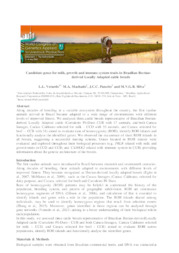Candidate genes for milk, growth and immune system traits in Brazilian Iberian: derived Locally Adapted cattle breeds.
Candidate genes for milk, growth and immune system traits in Brazilian Iberian: derived Locally Adapted cattle breeds.
Author(s): VERARDO, L. L.; MACHADO, M. A.; PANETTO, J. C. do C.; SILVA, M. V. G. B.
Summary: Along decades of breeding in a variable ecosystem throughout the country, the first taurine animals arrived in Brazil became adapted to a wide range of environments with different levels of improved fitness. We analyzed three cattle breeds representative of Brazilian Iberianderived Locally Adapted cattle (Curraleiro Pé-Duro CUR with 17 animals, and both Caracu lineages, Caracu Caldeano selected for milk ? CCD with 55 animals, and Caracu selected for beef -?CCB with 24) aimed to evaluate runs of homozygosity (ROH), identify ROH islands and functionally analyse the identified genes. We observed the occurrence of short ROH islands in all breeds, suggesting a successful matting scheme. Genes located in ROH islands were evaluated and explored throughout their biological processes (e.g. PRLR related with milk and growth traits in CCD and CCB; and CAMKK2 related with immune system in CUR) providing information about the genetic architecture of the breeds.
Publication year: 2022
Types of publication: Paper in annals and proceedings
Unit: Embrapa Dairy Cattle
Keywords: Bovino, Gado Leiteiro, Gene, Melhoramento Genético Animal
Observation
Some of Embrapa's publications are published as ePub files. To read them, use or download one of the following free software options to your computer or mobile device. Android: Google Play Books; IOS: iBooks; Windows and Linux: Calibre.
Access other publications
Access the Agricultural Research Database (BDPA) to consult Embrapa's full library collection and records.
Visit Embrapa Bookstore to purchase books and other publications sold by Embrapa.

